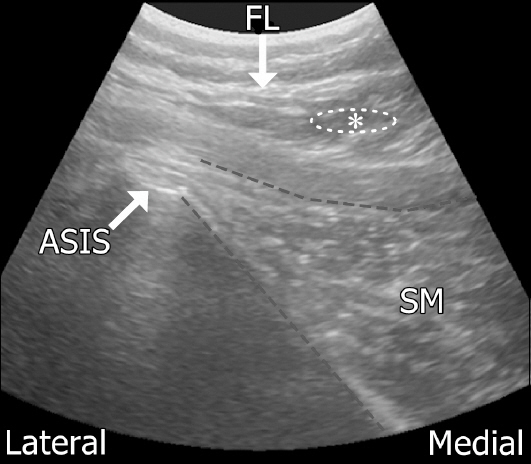Anesth Pain Med.
2017 Jan;12(1):81-84. 10.17085/apm.2017.12.1.81.
Concurrent meralgia paresthetica and radiculopathy of the left leg: A case report
- Affiliations
-
- 1Department of Anesthesiology and Pain Medicine, National Police Hospital, Seoul, Korea.
- 2Department of Anesthesiology and Pain Medicine, International St. Mary's Hospital, College of Medicine, Catholic Kwandong University of Korea, Incheon, Korea. uk201@hanmail.net
- KMID: 2369673
- DOI: http://doi.org/10.17085/apm.2017.12.1.81
Abstract
- Meralgia paresthetica (MP) is a painful mononeuropathy of the lateral femoral cutaneouse nerve (LFCN) characterized by localized symptoms of numbness, tingling, pain and paresthesia along the anterolateral thigh area. L4 and L5 radiculopathy is set of symptoms that include sharp, burning or shooting pain, which is usually localized to anterolateral leg area and along the dermatomal distribution. When symptoms of MP and lumbar disc disease occur together it is not easy to diagnose MP. We report a case of synchronous post-traumatic MP and radiculopathy due to intervertebral disc herniation at L3-4 and 4-5. A 59-year-old male patient was admitted to the emergency room with symptoms of low back pain with left severe L4, L5 radiculopathy. This patient also complained of numbness and paresthesia in the left anterolateral thigh. After detailed history taking and lateral femoral cutaneouse nerve block, he was diagnosed with MP.
MeSH Terms
Figure
Reference
-
1. Harney D, Patijn J. Meralgia paresthetica: diagnosis and management strategies. Pain Med. 2007; 8:669–77. DOI: 10.1111/j.1526-4637.2006.00227.x. PMID: 18028045.2. Majkrzak A, Johnston J, Kacey D, Zeller J. Variability of the lateral femoral cutaneous nerve: An anatomic basis for planning safe surgical approaches. Clin Anat. 2010; 23:304–11. DOI: 10.1002/ca.20943.3. Kim JE, Lee SG, Kim EJ, Min BW, Ban JS, Lee JH. Ultrasound-guided Lateral Femoral Cutaneous Nerve Block in Meralgia Paresthetica. Korean J Pain. 2011; 24:115–8. DOI: 10.3344/kjp.2011.24.2.115. PMID: 21716611. PMCID: PMC3111560.4. Trummer M, Flaschka G, Unger F, Eustacchio S. Lumbar disc herniation mimicking meralgia paresthetica: case report. Surg Neurol. 2000; 54:80–1. DOI: 10.1016/S0090-3019(00)00264-0.5. Po HL, Mei SN. Meralgia paresthetica: the diagnostic value of somatosensory evoked potentials. Arch Phys Med Rehabil. 1992; 73:70–2. PMID: 1729978.6. Nouraei SA, Anand B, Spink G, O’Neill KS. A novel approach to the diagnosis and management of meralgia paresthetica. Neurosurgery. 2007; 60:696–700. DOI: 10.1227/01.NEU.0000255392.69914.F7. PMID: 17415207.7. Patijn J, Mekhail N, Hayek S, Lataster A, van Kleef M, Van Zundert J. Meralgia Paresthetica. Pain Pract. 2011; 11:302–8. DOI: 10.1111/j.1533-2500.2011.00458.x. PMID: 21435164.8. Cho KT, Lee HJ. Prone position-related meralgia paresthetica after lumbar spinal surgery : a case report and review of the literature. J Korean Neurosurg Soc. 2008; 44:392–5. DOI: 10.3340/jkns.2008.44.6.392. PMID: 19137086. PMCID: PMC2615145.9. Cordato DJ, Yiannikas C, Stroud J, Halpern JP, Schwartz RS, Akbunar M, et al. Evoked potentials elicited by stimulation of the lateral and anterior femoral cutaneous nerves in meralgia paresthetica. Muscle Nerve. 2004; 29:139–42. DOI: 10.1002/mus.10515. PMID: 14694510.10. Grossman MG, Ducey SA, Nadler SS, Levy AS. Meralgia paresthetica: diagnosis and treatment. J Am Acad Orthop Surg. 2001; 9:336–44. DOI: 10.5435/00124635-200109000-00007. PMID: 11575913.11. Miller KJ. Physical assessment of lower extremity radiculopathy and sciatica. J Chiropr Med. 2007; 6:75–82. DOI: 10.1016/j.jcme.2007.04.001. PMID: 19674698. PMCID: PMC2647081.12. Moon SY, Cha YD, Lim DJ, Yang KH, Lee DI. Pulsatile subdural contrast image during attempted lumbar transforaminal epidural block: A case report. Anesth Pain Med. 2011; 6:24–7.13. Tharion G, Bhattacharji S. Malignant secondary deposit in the iliac crest masquerading as meralgia paresthetica. Arch Phys Med Rehabil. 1997; 78:1010–1. DOI: 10.1016/S0003-9993(97)90067-8.14. Margo K, Drezner J, Motzkin D. Evaluation and management of hip pain: an algorithmic approach. J Fam Pract. 2003; 52:607–17. PMID: 12899815.15. Dureja GP, Gulaya V, Jayalakshmi TS, Mandal P. Management of meralgia paresthetica: a multimodality regimen. Anesth Analg. 1995; 80:1060–1. DOI: 10.1097/00000539-199505000-00043. PMID: 7726412.
- Full Text Links
- Actions
-
Cited
- CITED
-
- Close
- Share
- Similar articles
-
- Meralgia Paresthetica Secondary to soft Tissue tuberculosis: a case report
- A Case of Meralgia Paresthetica
- Meralgia Paresthetica by Iliopsoas Bursa associated with Osteonecrosis of the Femoral Head: A Case Report
- Pulsed Radiofrequency Neuromodulation Treatment on the Lateral Femoral Cutaneous Nerve for the Treatment of Meralgia Paresthetica
- A Case of Meralgia Paresthetica





